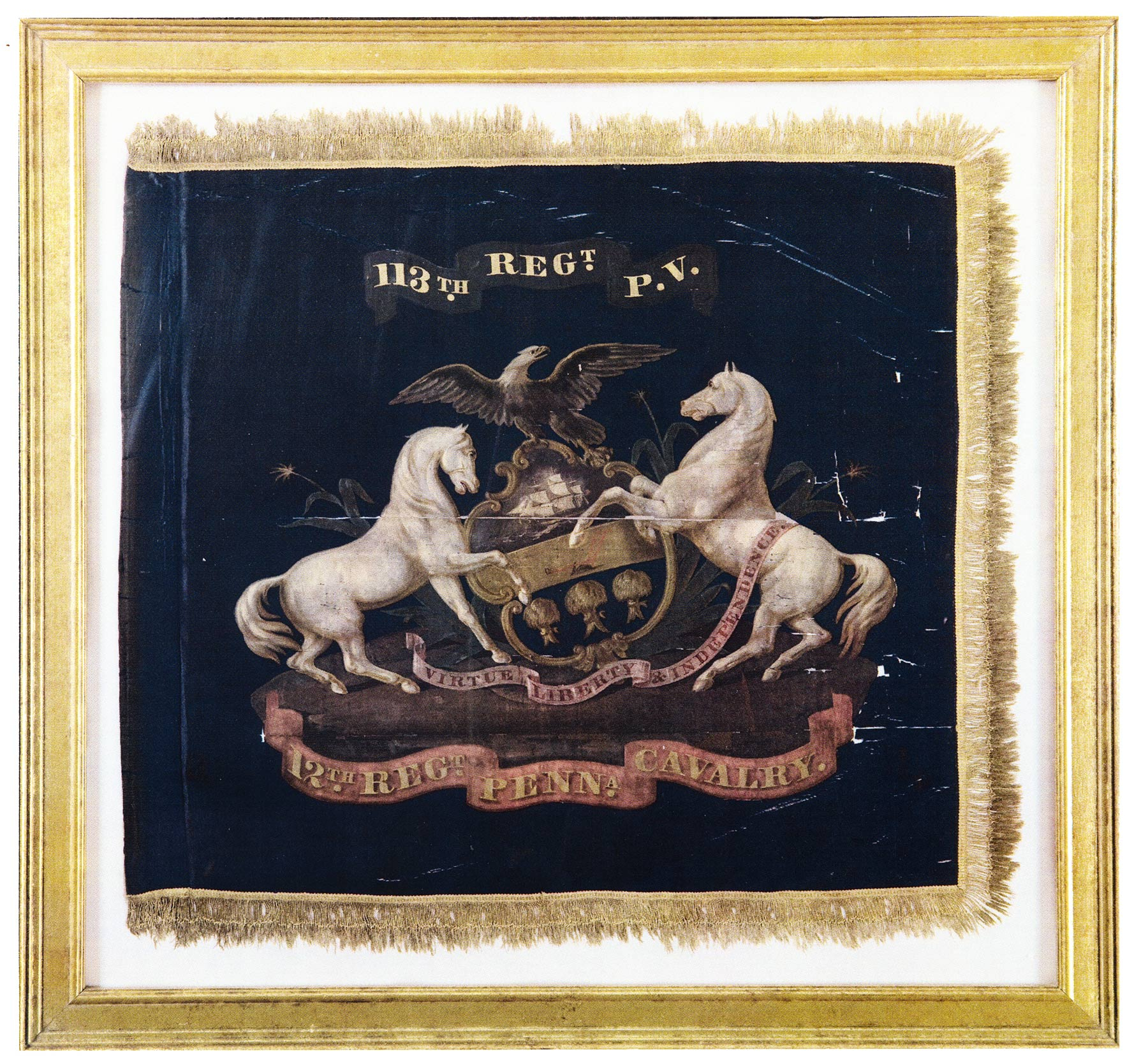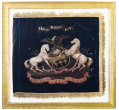site search
online catalog
BEAUTIFUL REGIMENTAL STANDARD OF THE 12TH PENNSYLVANIA CAVALRY

$35,000.00 SOLD
Quantity Available: None
Item Code: 1179-015
This cavalry standard is a real showpiece that would be the focal point of any cavalry collection and hard to match for a collector interested in Pennsylvania units or flags in general. It is wonderful combination of history and art, with tremendous eye appeal. Cavalry standards were the equivalent of infantry regimental colors, though smaller for better handling while mounted, and this follows the US army regulations in general dimensions (specified as 29 by 27 inches without fringe) and as is typical of many state volunteer regiments substitutes the state arms painted on the blue field for the embroidered arms of the U.S. as the central motif, using both Pennsylvania’s designation of the unit in its line of volunteer regiments in a scroll at top, “113th REGT P.V.” and its branch of service designation in another at bottom: 12th REGT PENNA CAVALRY.
The regiment was recruited broadly across the state and formally organized at Philadelphia in November 1861. This flag was likely among four presentations of flags made to them in 1862 documented by Sauers et al. in Advance the Colors. They note production of a standard for the regiment by Horstmann Brothers in May 1862 that thereafter left no trace in the written record and did not make its way into the state collection after the war. It could also be among three other presentations to the regiment by friends, also in 1862: a “handsome silk flag” presented by Mrs. Colonel William Frishmuth in February; a “handsome regimental flag” by Mr. A.V. Zane in March; or, “colors” by Mayor Alexander Henry in April.
Civil War Data provides 46 specific dates on which the regiment suffered losses of some sort, an indicator of its active service in the Middle Department, Department of West Virginia, Army of the Potomac, and Army of the Shenandoah. It was involved in the opening of the Second Bull Campaign and in the opening and closing phases of the Gettysburg Campaign, and a good number of small unit actions while on picket, patrol, guard and scouting duty. By the time the regiment mustered out in July 1865 its casualties included 2 officers and 32 enlisted men in killed or mortally wounded plus many others wounded, captured, missing, etc.
It was sent to Washington in April 1862 and in June was guarding and patrolling the Orange and Alexandria Railroad near Manassas Junction. While reconnoitering in the Second Bull Run Campaign it got into a fight near Bristoe and was later assigned to guard the Potomac near Alexandria and held in reserve in the Antietam Campaign, but took part in scouting and following Lee’s retreating forces after the battle. This was followed by more guard and patrol duty, this time along the tracks of the Baltimore and Ohio, and was engaged in a fight at Fisher’s Hill. In June 1863 it was involved in the opening phases of the Gettysburg Campaign as part of Milroy’s division, fighting Lee’s advance troops led by Ewell, losing some 172 men at Winchester, but managing to break through the Confederate cordon. In the closing phases of the campaign it took part in the pursuit of Lee and had a hand in the capture of Confederate wagon trains at Cunningham Crossroads and Mercersburg.
In 1864 the regiment was posted in the northern Shenandoah and in July was part of a fighting retreat in the face of Jubal Early’s advance, fighting at Pleasant Valley, Crampton’s Gap, Winchester, and Kernstown. In the fall it was sent to Charlestown to remount and re-equip, and during the winter did further patrol and guard duty to intercept Confederate raiders and defend its camp from occasional attacks along the rail line from Winchester to Harpers Ferry. In March 1865 it crossed the Blue Ridge to deal with guerillas and was engaged at Harmony on March 22 with some loss, returning to Winchester in April as part of the Army of the Shenandoah. By the time the regiment mustered out in July 1865 it had suffered the loss of 2 officers and 32 enlisted men in killed or mortally wounded alone, with many more wounded who recovered to some degree. As side note, during 1865 the regiment was under the command of Col. Marcus A. Reno, who would later earn something of a reputation serving under Custer in the 7th U.S. Cavalry.
The flag has been professionally conserved and mounted by Textile Preservation Associates (Fonda Thomsen) and is accompanied by a folder including their 2003 and 2004 treatment proposals, analysis, and reports that include detailed drawings of both sides of the flag, before and after color photos, as well as recommendations for handling, display, storage, etc.
The flag is beautifully conserved on a white background in a gilt frame 38 inches tall by 40 inches wide. As the TPA technical drawings and description accompanying it make clear, the flag was painted to read correctly on both sides of a single layer of blue silk and is mounted with the sleeve edge at left and the fly at right. The flag itself measures 31 ½ inches on the leading edge and 33 inches along the fly. We quote from the TPA analysis and treatment reports: “Across the top of the fly is painted a 1 3/4” black ribbon in three sections with the center raised. The ribbon holds the unit designation in ½” and ¾” white Roman lettering as follows: “113th Regt. P.V.” Painted in the center of the fly below the ribbon is the state seal of Pennsylvania. The seal depicts a 9” by 7 ½” shield in the center placed on a mound. The shield is divided into three horizontal sections with a ship, plow and wheat sheaves. An eagle with a 10 ½“ wingspan perches upon the top of the shield with his head turned toward the fly. To either side of the shield there is a rearing white horse with corn stalks in the background. Below the shield and horses is a pink ribbon, 3/4 “ wide, in three sections. The ribbon is inscribed with the motto “VIRTUE / LIBERTY / & INDEPENDENCE.” The fly end of the ribbon arcs upsward over the back of the horse on that side. Below the mound is painted a red ribbon, 1 5/6” wide, in three sections with center lowered. This ribbon holds another unit designation . . . in 3/8” and 3/4” Roman lettering in gold: 12th REGT. / PENNA. / CAVALRY.” The flag has a 2 3/4“ knotted gold silk fringe sewn to the obverse side on the top, fly and bottom edges. There is a 2” pole sleeve lined with cotton and open at both ends for attachment to a staff. The painted image is finished on the reverse side.”
The condition and presentation is excellent, with strong color to the silk and to the oil paint. There are some small holes and losses, mostly on the fly end, as should be expected from use, but they are not many or large, and show plainly in our images. The paint is almost entirely intact with only the slightest slivers of loss along a separation line across the shoulders of the horses and above the lower scroll from horizontal folds during storage. The conservation consisted largely of cleaning, placement of a few detached or semi-detached pieces and stabilization. Interested buyers can consult the treatment reports and before and after photographs, etc., along with the recommendations for display and handling.
The only thing missing in the TPA description is that figures on the flag are incredibly dynamic, with the horses in different postures, that on the left raising a hoof and about to rise, the one on the right rearing up and slightly back with both forelegs off the ground, the eagle twisting slightly to the viewer’s left and looking to the viewer’s right with mouth open in a cry, the rococo shield slightly canted to the left, and the lettering of the state motto done in gentle curves like the regimental designation at bottom, but placed on a long ribband unfurling on the ground beneath the horse at left and rising up to drape over the rearing horse at right- all this combined with the American bald eagle and images of a ship, plough, and sheaves of wheat, with cornstalks behind, symbolizing commerce, farming, agriculture and abundance, in short: peace and prosperity, along with virtue, liberty and independence, an especially charged combination of symbols on a flag to be carried in conflict.
This is a knock-out piece. [sr]
EXTRA SHIPPING REQUIRED.
~~~~~~~~~~~~~~~~~~~~~~~~~~~~~~~~~~~
THIS ITEM, AS WITH ALL OTHER ITEMS AVAILABLE ON OUR WEB SITE,
MAY BE PURCHASED THROUGH OUR LAYAWAY PROGRAM.
CLICK HERE FOR OUR POLICIES AND TERMS.
THANK YOU!
Inquire About BEAUTIFUL REGIMENTAL STANDARD OF THE 12TH PENNSYLVANIA CAVALRY
For inquiries, please email us at [email protected]
Most Popular
Historical Firearms Stolen From The National Civil War Museum In Harrisburg, Pa »
Theft From Gravesite Of Gen. John Reynolds »
Selection Of Unframed Prints By Don Troiani »
Fine Condition Brass Infantry Bugle Insignia »
British Imported, Confederate Used Bayonet »
Scarce New Model 1865 Sharps Still In Percussion Near Factory New »
featured item
VERY SCARCE CONFEDERATE SWORD BELT WITH VIRGINIA BUCKLE
This buff leather, Model-1851 sword belt comes complete with sword hangers (one detached but present), all brass hardware, and a very fine Virginia State Seal belt plate. No shoulder strap present. The belt is of buff leather and shows honest use.… (1268-357). Learn More »
site search
Upcoming Events
May 16 - 18: N-SSA Spring Nationals, Fort Shenandoah, Winchester, VA Learn More »




